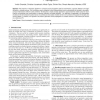Free Online Productivity Tools
i2Speak
i2Symbol
i2OCR
iTex2Img
iWeb2Print
iWeb2Shot
i2Type
iPdf2Split
iPdf2Merge
i2Bopomofo
i2Arabic
i2Style
i2Image
i2PDF
iLatex2Rtf
Sci2ools
TVCG
2008
2008
AD-Frustum: Adaptive Frustum Tracing for Interactive Sound Propagation
We present an interactive algorithm to compute sound propagation paths for transmission, specular reflection and edge diffraction in complex scenes. Our formulation uses an adaptive frustum representation that is automatically sub-divided to accurately compute intersections with the scene primitives. We describe a simple and fast algorithm to approximate the visible surface for each frustum and generate new frusta based on specular reflection and edge diffraction. Our approach is applicable to all triangulated models and we demonstrate its performance on architectural and outdoor models with tens or hundreds of thousands of triangles and moving objects. In practice, our algorithm can perform geometric sound propagation in complex scenes at 4-20 frames per second on a multi-core PC.
| Added | 16 Dec 2010 |
| Updated | 16 Dec 2010 |
| Type | Journal |
| Year | 2008 |
| Where | TVCG |
| Authors | Anish Chandak, Christian Lauterbach, Micah T. Taylor, Zhimin Ren, Dinesh Manocha |
Comments (0)

